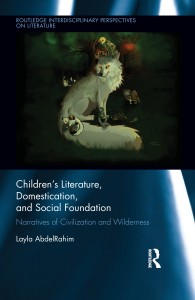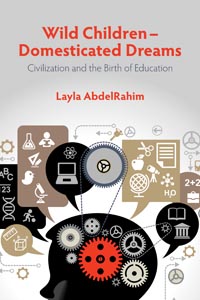I am an independent scholar and author with no institutional funding. Please, consider supporting me on Patreon so I can continue to do the work. Thank you!
Summary
Abstract for Ph.D. dissertation,
defended with excellence, September 2011 (external examiner: Jack Zipes):
Order and the literary rendering of chaos: children’s literature as knowledge, culture and social foundation (full PDF)
In English:
Ever since the human animal devised a system of technologies for abstract thought through language, the war on wilderness has become a one way path towards alienation, civilisation and literature. In this work, I examine how the civilised narrative orders experience by means of segregation, domestication, breeding, and extermination; whereas, I argue that the stories and narratives of wilderness project chaos and infinite possibilities for experiencing the world through a diverse community of life.
One of my goals in conducting this study on children’s literature as knowledge, culture and social foundation has been to bridge the gap between science and literature and to examine the interconnectedness of fiction and reality as a two-way road. Another aim has been to engage these narratives in a dialogue with each other as I trace their expression in the various disciplines and books written for both children and adults as well as analyse the manifestation of fictional narratives in real life. This is both an interand multi-disciplinary endeavour that is reflected in the combination of research methods drawn from anthropology and literary studies as well as in the content that traces the narratives of order and chaos, or civilisation and wilderness, in children’s literature and our world.
I have chosen to compare and contrast three fictional children’s books that offer three different real-world socio-economic paradigms, namely, A.A. Milne’s Winnie-the-Pooh projecting a civilised monarcho-capitalist world, Nikolai Nosov’s trilogy on The Adventures of Dunno and Friends as presenting the challenges and feats of an anarchosocialist society in evolution from primitivism towards technology, and Tove Jansson’s Moominbooks depicting chaos, anarchy, and wilderness that contain everything, including encounters with civilisation, but most of all an infinite love for the world.
Stemming from the basic question in research methodology on how we know the world, I first examine the construction, transmission, and acquisition of knowledge, particularly through the lens of Bourdieu’s theory of praxis, as well as the critique of language and literacy through Zerzan’s, Ong’s, and Goody’s studies on the links between literacy, debt and oppression. Regarding children’s literature depicting the three socioiv economic paradigms, I chose three books with which I have been familiar since childhood, i.e. in whose narratives I have “native fluency” and, in this sense, this work is also about “anthropology at home”. Moreover, I compared and contrasted the underlying premises not only in the three books, but also with the unfolding narratives of wilderness and civilisation in real life, that I inserted in the form of ethnographic/journal entries throughout the dissertation. As I examine the very nature of literature, culture, and language and the civilised structures that domesticate the world through the threat of death and the expropriation of food, I also trace the presence of these narratives in the scientific (the Malthusian-Darwinian narrative), religious, and other cultural expressions and the challenges provided by anarchist science and theory (Kropotkin) as well as wild children’s books such as Jansson’s Moomintrolls.
Keywords: children’s literature, anthropology, anarchy, civilisation critique, chaos, narratives, literary theory, primitivism, ontology, epistemology.
En français:
Titre:
L’ordre et la mise en scène littéraire du chaos: la littérature pour enfants comme savoir,
culture, et fondation sociale
Résumé:
Depuis que l’animal humain a conçu un système de technologies pour la pensée abstraite grâce au langage, la guerre contre le monde sauvage est devenu une voie à sens unique vers l’aliénation, la civilisation et la littérature. Le but de ce travail est d’analyser comment les récits civilisationnels donnent une structure à l’expérience par le biais de la ségrégation, de la domestication, de la sélection, et de l’extermination, tandis que les récits sauvages démontrent les possibilités infinies du chaos pour découvrir le monde en toute sa diversité et en lien avec sa communauté de vie.
Un des objectifs de cette thèse a été de combler le fossé entre la science et la littérature, et d’examiner l’interdépendance de la fiction et la réalité. Un autre objectif a été de mettre ces récits au coeur d’un dialogue les uns avec les autres, ainsi que de tracer leur expression dans les différentes disciplines et oeuvres pour enfants et adultes mais également d’analyser leur manifestations c’est redondant dans la vie réelle. C’est un effort multi-disciplinaires qui se reflète dans la combinaison de méthodes de recherche en anthropologie et en études littéraires.
Cette analyse compare et contraste trois livres de fiction pour enfants qui présentent trois différents paradigmes socio-économiques, à savoir, «Winnie-l’Ourson» de Milne qui met en place un monde civilisé monarcho-capitaliste, la trilogie de Nosov sur «les aventures de Neznaika et ses amis» qui présente les défis et les exploits d’une société anarcho-socialiste dans son évolution du primitivisme vers la technologie, et les livres de Moomines de Jansson, qui représentent le chaos, l’anarchie, et l’état sauvage qui contient tout, y compris des épisodes de civilisation.
En axant la méthodologie de ma recherche sur la façon dont nous connaissons le monde, j’ai d’abord examiné la construction, la transmission et l’acquisition des connaissances, en particulier à travers la théorie de praxis de Bourdieu et la critique de la civilisation développée dans les études de Zerzan, Ong, et Goody sur les liens entre l’alphabétisation, la dette et l’oppression. Quant à la littérature pour enfants, j’ai choisi trois livres que j’ai connus pendant mon enfance, c’est-à-dire des livres qui sont devenus comme une «langue maternelle» pour moi. En ce sens, ce travail est aussi de «l’anthropologie du champ natif».
En outre, j’analyse les prémisses sous-jacentes qui se trouvent non seulement dans les trois livres, mais dans le déroulement des récits de l’état sauvage et de la civilisation dans la vie réelle, des analyses qui paraissent dans cette thèse sous la forme d’extraits d’un journal ethnographique. De même que j’examine la nature de la littérature ainsi que des structures civilisées qui domestiquent le monde au moyen de menaces de mort, je trace aussi la présence de ces récits dans l’expression scientifique (le récit malthusiendarwinien), religieuse, et dans autres expressions culturelles, et réfléchis sur les défis présentés par la théorie anarchiste (Kropotkine) ainsi que par les livres pour enfants écrits du point de vue sauvage, tels que ceux des Moomines.
Mots-clés: littérature pour enfants, anthropologie, anarchie, critique de civilisation, chaos, théorie littéraire, primitivisme, ontologie, epistemologie, sociologie.
A chapter presented at the conference “Off to See the Wizard: Quests for Memory and Culture in Children’s Literature” on Saturday, 19th March, 2005.
Another chapter presented at Childhoods 2005 – a global conference addressing modern childhood and youth. organised by a group of Norwegian researchers of the University of Oslo (UiO), the Norwegian Social Research (NOVA) and the Childwatch International Research Network (CWI) in Oslo in June-July 2005.
“Society needs the spectacle of punishment not so much as to render justice as to reconfirm the world and the self”, says Steven Box in Deviance, Society & Reality (1971).
Children’s literature – like its adult counterpart is an ambiguous and amorphous body that reflects and transmits reality and culture, while simultaneously challenging them both.
The works I chose for this study depict imaginary creatures inhabiting imaginary worlds, yet their realities are so organised that in each we recognise ourselves. Nikolai Nosov wrote about mites in Flower Town, who after industrialisation and a technological/scientific revolution travel around the globe and finally venture to the moon. Tove Jansson brought to life the imaginary Moomintrolls and their harmonious world, while Alan Alexandre Milne depicted a boy’s friendship with Winnie the Pooh and this boy’s reign in the imaginary kingdom of toys come-to-life. However, the premises on which these worlds are organised are dialogically consistent with the real-life-referent: our world.
My analysis rests on the contention that when we write or read about imaginary worlds, we extract patterns from events and occurrences so as to arrive at order and to make sense of it just as we do in “real” worlds. Thus, regardless of the author’s intent, books offer a specific set of rules that can “convince” the reader and can make credible even an imaginary world. Credibility, rules, representation – even in the case of the fantastic – depend on the “knowledge” about the “real” world that the author holds, questions, or argues for and each of the above authors had a different view of human nature and of social relations. How characters deal with deviance is the result of their nature: they might be selective in their reaction to it, as does Piglet when scorning Eyore’s deviance (melancholy and social awkwardness) yet ignoring Winnie the Pooh’s earnest and honest avarice; they might punish it in the manner of the characters from Narnia, they might work together to awaken the “conscience” of Dunno in Nosov’s trilogy, or they might not notice it at all as do the blithe dwellers of Jansson’s Moomin Valley. Here I link knowledge and deviance to order and chaos and propose to examine the question of their literary rendition. The question of knowledge shall thus remain central to my work.
Consequently, in this research I set out to demonstrate that the three icons of children’s literature in Russia, Scandinavia and Britain, raise fundamental questions about the problems of definitions of justice and propose alternative ways for understanding and representing chaos and order. I compare and contrast the legal and philosophical definitions of crime, deviance, punishment and justice, first. Then, I proceed to compare and contrast these notions with the way in which they are adapted, modified or challenged in the three children’s books. These questions, I argue, transcend national and cultural borders and can shift vital considerations in reading what we consider to be children’s literature.
Part II published in “The Paulinian Compass”, July 2010, available in PDF here:
“Genealogies of Wilderness and Domestication in Children’s Narratives: Understanding Genesis and Genetics in the Untangling of Identity“










Sounds very interesting. Would like to read more about your analysis and conclusions.